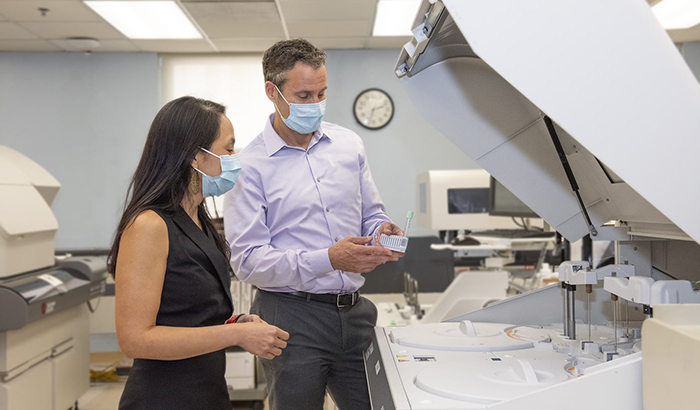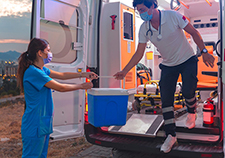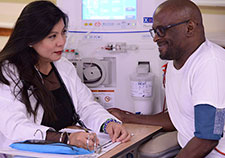Office of Research & Development |
 |


Drs. Michelle Estrella and Michael Shlipak of the San Francisco VA believe the cystatin C test is much more accurate in detecting kidney disease than the one that has long been used in standard medical practice, the creatinine test. Here, they are working with a machine that measures both tests. (Photo by Edgardo Caballero.)
September 17, 2020
By Mike Richman
VA Research Communications
More than 15 years ago, Dr. Michael Shlipak began studying a test he believed to be much more accurate in detecting kidney disease than the one in standard practice for decades.
Shlipak, then the chief of general internal medicine at the San Francisco VA Health Care System, compared the relatively unknown cystatin C test, which Swedish scientists created in 1985, to the long-used creatinine test. Cystatin C is a protein that lives in all cells in the body; creatinine is a chemical byproduct of muscle activity. Both are filtered through the kidneys and are measured via a blood test, so the blood level reflects the speed of the filtering. Low filtration rates indicate a kidney problem.
His first big paper on cystatin C appeared in the New England Journal of Medicine in 2005. Shlipak and his team found that elevated blood levels of cystatin C accurately predict higher risks of heart disease, stroke, and death among elderly people with no known kidney problems. The creatinine test misses those risks almost entirely, according to the researchers.
"We think patients need the cystatin C test for everyday decision-making, and using it may lead to earlier detection of kidney disease and fewer adverse events from kidney disease."
Fast forward to today, and the creatinine test is still the predominant choice among nephrologists, who treat kidney disease. The question is why.
“That study put cystatin C on the map as saying, `Wait a minute. This may be a marker that could be useful,’ Shlipak says. “Cystatin C is clearly superior to creatinine because it overcomes the major weakness of creatinine’s inaccuracy in people with reduced muscle or limited activity. The obvious mystery is why after 15 years we’re still not using it very much. I can’t explain why the medical field is content to continue using creatinine when we have a better alternative. Unfortunately, some areas of medicine, like kidney testing, are very slow-moving.”
But Shlipak is trying to pick up the pace. He is teaming up with the chief of nephrology at the San Francisco VA, Dr. Michelle Estrella, to improve kidney care for Veterans, in part, by making the cystatin C test available across the VA system. The two are co-leading a VA-funded study that will implement the test at the VA hospitals in San Diego and Houston, before it is accepted nationwide. They have also spoken to VA decision-makers about the test, including Dr. Michael Icardi, VA’s national director of pathology and laboratory medicine services, and Dr. Susan Crowley, VA’s national program director for kidney disease and analysis.

VA's new "burden-free" study method finds two blood pressure drugs equally effective

Hep C-positive organs, safe and effective for most transplant recipients

Gene variants tied to kidney disease have only modest cardiovascular effect in African Americans
Icardi is “very enthusiastic” about incorporating the cystatin C test in VA. The procedure, he notes, does not have the limitations that come with the creatinine test, which is much less expensive per examination. But “with the advent of new measurement techniques, the financial advantage to creatinine testing is diminished,” he adds.
Crowley wants the cystatin C test made available through each of VA’s 22 VISNs (Veteran Integrated Service Networks). “Working with the VHA National Kidney Program and the VHA Pathology and Laboratory Medicine Service, Dr. Shlipak has been championing greater adoption of cystatin C measurement by VA providers,” she says. “Leveraging VA data, he and others have also been studying the use of cystatin C as a risk prediction marker for death among Veterans.”
Shlipak knows of only two VA hospitals that do in-house blood sampling for cystatin C: the San Francisco VA and the James A. Haley Veterans’ Hospital in Tampa, Florida. Some VA facilities that offer cystatin C measurement outsource the test to an external lab, but doing so is far less effective, he notes.
“When you have a hospitalized patient, you’re making decisions hourly or at least twice daily,” says Estrella, who, like Shlipak, is affiliated with the University of California, San Francisco. “When you send a test out that comes back in two or three days, the information arrives too late. You may be dosing blood thinners, antibiotics, and chemotherapy drugs. You need to know how the kidney is functioning, so you don’t prescribe too much or too little.”
Kidneys perform life-sustaining functions that keep the rest of the body in balance, including by removing waste products and excess fluids. They also maintain a safe level of blood chemicals and control blood pressure. But a gradual loss of their ability to filter blood properly can lead to kidney disease, which can progress to kidney failure. The latter requires a kidney transplant or dialysis, which rids the body of waste products and excess fluids.
Nearly 40 million U.S. adults, including many Veterans, are estimated to have chronic kidney disease, a huge risk factor for heart failure, heart attacks, and strokes. Kidney disease is the ninth-leading cause of death in the United States.
People at high risk for kidney disease include those with diabetes, hypertension, heart failure, and a family history of the condition. The disease disproportionately affects minority and low-income patients, including Blacks, Hispanics, and Native Americans. People age 65 and older are also at increased risk.
The main diagnostic method for detecting and managing kidney disease, planning for dialysis, and evaluating the option of transplantation is the estimated glomerular filtration rate (eGFR). The creatinine test or cystatin C test can calculate that estimation.
The creatinine test has existed for about 70 years. The result is based partly on how much creatinine a person produces by using their muscles, which varies enormously. The test mostly comes up short, Shlipak explains, with people age 65 and older, many of whom make very little creatinine because they live sedentary lives and don’t use their muscles much. Consequently, older people may still show normal blood creatinine levels even after developing kidney disease. He says the creatinine test is also confusing when used with Black people, who have greater muscle mass than white people on average (see sidebar).
To account for the effect of muscle mass and activity on creatinine, the eGFR calculation includes “fudge factors” of age, sex, and race, according to Estrella. A score of 60 or below usually signals that a person has a kidney problem. By the time the score drops to 30, a person needs to see a nephrologist because he or she has complications from kidney disease or is quickly approaching the need for dialysis. Estrella calls 30 the “crisis point.”
But in the case of older adults, Estrella notes, the calculation based on creatinine is calibrated so they are believed to have worse eGFR levels. She says if a white man is 40 years old and has a creatinine level of 1.15, he has an eGFR of 80. But an 80-year-old white man with the same creatinine level may have an estimated score of 60. “The problem is that the test is just off,” Estrella says. “When patients become frail, they hardly make any creatinine. So sometimes we’ll see in older patients the creatinine suggests the kidney function is over 100, but in fact the eGFR is only 40 with cystatin C. The tests can be dramatically different because older or sicker people often aren’t making any creatinine.”
In contrast, the cystatin C test provides an unbiased estimate of kidney function. “In our normal course of living, we have this natural turnover of our cells,” Shlipak says. “We all make about the same amount of cystatin C. From about the age of 1 until 90, it’s consistent. This doesn’t really fluctuate human to human like creatinine.”
“The tests are both very easy to measure,” he adds. “They’re both automated tests run by large clinical chemistry machines that can run hundreds of tests simultaneously. But cystatin C simplifies things by making it an eGFR you can believe. It’s more trustworthy than the creatinine test. The result is easier to interpret because it’s not biased by the patient’s health status.”
The medical community, Shlipak says, is relying on a creatinine test that is “far from ideal” and works least well in the patients who need it most.
“Particularly with old people who take so many medications, if we’re not measuring kidney function correctly, we’re setting them up for adverse events and medical errors that are preventable,” he says. “With a kidney blood test, we really want to measure something that we all make at the same rate and is filtered out of the body by the kidney. That conundrum led me to seize this alternative of cystatin C. As we started to study it, we realized just how bad creatinine is because there was never an alternative test to compare it with. The more we studied, the more we realized how often clinicians are blind to the patient’s progressing kidney disease.”
Shlipak has authored nearly 200 papers on the cystatin C test. He co-founded and directs the Kidney Health Research Collaborative at the San Francisco VA and the University of California, San Francisco. Last year, he received the John B. Barnwell Award—VA Clinical Science Research and Development's highest honor—for pioneering the use of cystatin C to detect early kidney disease in older people. His research has demonstrated how much better the cystatin C test is than the creatinine test and that Veterans and older adults need the cystatin C test to get optimal care.
Partly because of his work, international guidelines now recommend measuring cystatin C to improve the diagnosis and staging of kidney disease.
For kidney disease detection in VA, Shlipak and Estrella are envisioning a triple-marker system involving the cystatin C test, the creatinine test, and a test that checks urine for a protein called albumin. Albumin, normally found in the blood, is filtered by the kidneys. Abnormal amounts of albumin leak into the urine when the kidneys are damaged.
However, the two colleagues recognize that making the triple-marker system available is not enough. They believe that closing the knowledge gaps in kidney testing and kidney disease treatment among providers is critical to preventing the disease and slowing its rate among Veterans. They recently launched the VA initiative “CKD [Chronic Kidney Disease] Cascade of Care” to do just that.
“Our opinion is that for Veterans at high risk of kidney disease, such as those with hypertension, diabetes, or heart disease, we should order all three tests,” Shlipak says. “Then you can accurately diagnose kidney disease. You can also stage the severity of kidney disease and choose the right therapies based on the combination of the tests. It’s hard for me to make a real justification for why we need to keep using creatinine. But people are so used to it that it would be a drastic leap to say, `Okay, we’re going to stop using creatinine after 70-plus years of it being the only test.”
Estrella says VA is ahead of the private sector in understanding the cystatin C test’s potential over the creatinine test.
“We think patients need the cystatin C test for everyday decision-making,” she says, “and using it may lead to earlier detection of kidney disease and fewer adverse events from kidney disease. The first step is to make the test available. We also need to educate providers on how you use it and why it has advantages. A critical step is also convincing labs that cystatin C is easy to measure and will be used by clinicians once the test is made available. All of this will come in time.”
Two male Veterans the same age but of different races—one white, one Black—have the same blood creatinine level. But the assessment of how well their kidney is functioning is calculated differently.
Why is that so?
In interpreting the results of a creatinine test, clinicians are instructed to adjust for race. Some experts contend that leads to biased scoring of one’s estimated glomerular filtration rate (eGFR). That, in turn, could create confusion about whether a person should be referred to a nephrologist or is a candidate for treatments such as a kidney transplant.
So says Dr. Michael Shlipak of the San Francisco VA Health Care System. He has been a huge advocate of the cystatin C kidney function test, which is not biased by race, and is co-leading efforts with his colleague Dr. Michelle Estella to get it accepted in the VA system (see main story).
“When healthy Black and white people have been studied, Blacks tend on average to have more muscle,” Shlipak says. “Their bodies will make more creatinine. The problem is that most people aren’t average, and they come in all sizes. The differences in muscle within a group of white men are much larger, for example, than the average difference between whites and Blacks.
“We are forced to use these types of assumptions to guess how much muscle people have based on their age, sex, and race to calculate eGFR,” he adds. “But these are just work-arounds because the creatinine test itself is flawed. If you need to make assumptions that feel uncomfortable just in using a test, then something is wrong with the test.”
A recent study by University of Pennsylvania researchers on the use of race to estimate kidney function highlighted the racial bias of the creatinine test. The researchers found that patients with an eGFR of less than 30 were referred to kidney specialists. They gave an example of a white patient whose eGFR was 28. A Black patient with the same creatinine level would get a race correction under a formula that raises the level to 33. The Black patient would not be referred to a specialist, according to the study.
“The creatinine equations to guess kidney function originated with good intentions,” Shlipak says. “The people who developed the formula were trying to equalize creatinine by calibrating it for non-kidney influences and relied on factors like race and age to do so. But the solution requires the implausible assumption that all white people and all Black people are different in this fixed way. It introduces race into patient-doctor decision making in a way that’s very uncomfortable. Race is not a biological factor. It’s a social construct. For years, many patients and doctors have been suspicious about why someone’s race determines how you interpret their kidney function.”
The National Kidney Foundation and the American Society of Nephrology recently formed a joint task force to examine the inclusion of race in estimating eGFR. The task force is supposed to issue its final recommendations this year. The cystatin C test is expected to be one of the solutions that is discussed.
Some university medical centers, including the University of California, San Diego, have made the cystatin C test available because of the race issue, according to Shlipak. The University of California, San Francisco will do so soon, he says.
“There’s been a national reckoning about this creatinine race issue that is pushing VA and the private sector to take the cystatin C test more seriously,” he says.
--- Mike Richman
VA Research Currents archives || Sign up for VA Research updates